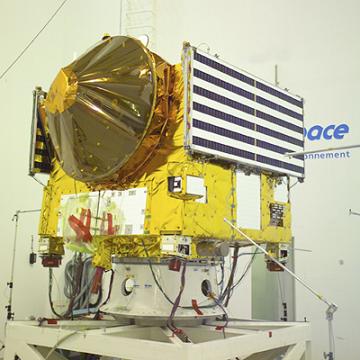Today the Venus Express spacecraft will be flown from its testing facility in France to the Baikonur Cosmodrome

The Venus Express spacecraft has completed the final testing phase in Europe and is ready to be sent to the launch site at the Baikonur Cosmodrome in Kazakhstan. A year and a half after its sister spacecraft Mars Express arrived at Mars, Europa's new planetary spacecraft is ready to begin the first step of its journey towards Earth's twin planet - the mysterious Venus.
Operation Venus Express was proposed back in 2001 as a concept mission that would utilize as much as possible of the original design of Mars Express and use it for another planetary mission. The mission to Venus was officially approved in 2002 by the Scientific Program Committee of the European Space Agency and the tender for its construction was won in October 2002 by EDAS - Astrium, which was assisted by 25 subcontractors from 14 European countries. The spacecraft is currently at the Astrium-owned Interspace facility in Toulouse, France, where it has been undergoing testing since October 2004.
"The spacecraft really deserves its name. "Never before has a European Space Agency mission been launched at such a speed," says Don McCoy, project manager on behalf of the European Space Agency. In total, it took us 4 years from the idea to the launch.
Work on Venus Express began in earnest eight months before the launch of Mars Express. This means that continuity was maintained among the employees in the program and among the members of the industrial consortium. 34 months later, the spacecraft has passed the flight readiness test and is ready for transfer and therefore launch. "We are proud of the achievement that was only possible thanks to the cooperation between the European Space Agency, industry and the scientific community." Don McCoy said.
The spacecraft was built by Alenia Spazio of Turin, Italy, and brought to Toulouse with its seven scientific instruments, most of which were inherited from the Mars Express and Rosetta missions. These instruments will provide new clues about the strange features of the planet that remain unexplained after 20 Russian and American missions have visited Venus since 1964.
The mission will provide the most in-depth observation and study ever of Venus' atmosphere. It will also try to dig into mysteries such as the faster rotation of the atmosphere compared to the planet's surface as well as the polar vortices. The spacecraft will also study the planet's thermal balance and the role of the strongest greenhouse effect in the entire solar system, as well as the structure and dynamics of clouds and the signatures of ultraviolet light above the cloud cover.
In Toulouse, the spacecraft underwent two major tests at the systems level and tests of the subsystems before and after environmental tests. These tests included, among other things, vibration tests and acoustic tests which are essential to know if the systems will survive the launch. The spacecraft and its systems were also subjected to heat and vacuum tests, to ensure that the spacecraft would survive the cold of deep space, as well as a series of experiments in which solar radiation was simulated, to ensure that the spacecraft would withstand the harsh thermal conditions created by Venus' close proximity to the sun.
The spacecraft is similar in design to the Mars Express but has been redesigned with some adjustments that will allow it to deal with the very different environment around Venus. Venus Express includes improved thermal control systems to prevent the spacecraft from overheating because the temperature in the region of Venus is 4 times greater than that near Mars. Since the spacecraft will be closer to the Sun than the Mars Express there will be better availability of solar radiation to power the spacecraft. And therefore the solar collectors were reduced. Also, the new Gallium-Arsenide technology makes them more tolerant to high temperatures. Unlike the Mars Express, instead of one high-power antenna, the Lunas Express has two such antennas pointing in opposite directions. Actually as seen from Venus, Earth is an outer planet and can be anywhere in the sky relative to the Sun. Two antennas will allow the spacecraft to communicate with the Earth in any situation, and always make sure that the side where the delicate instruments are away from the sun.
The Venus Express is now inside its container which will be sealed this week and loaded onto a truck to Toulouse-Blaillac airport. From there it will be flown through Moscow aboard a commercial Antonov 124 cargo plane and will arrive at the launch facility on August 7.
